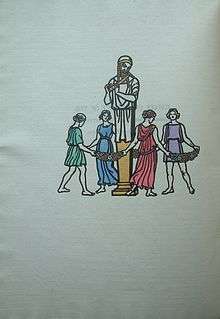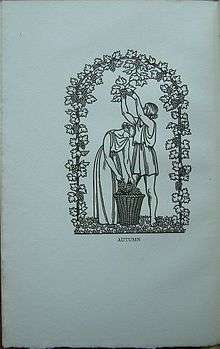Vivien Gribble
Vivien Massie Gribble (1888 to 6 February 1932) was a wood engraver who was active at the beginning of the twentieth century. She was a pupil of Noel Rooke at the Central School of Arts and Crafts and exhibited regularly with the Society of Wood Engravers.[1]
Biography


Gribble was born into a wealthy family, and was the third of six children. She studied first in Munich and then at the Slade and the Central School of Arts and Crafts under Noel Rooke, and clearly made an early impression on her teachers. During the First World War she joined the Land Army. Her brother Julian, who won the V.C., died of influenza right at the end of the war; Gribble designed a memorial window for him.[2] In 1919 she married Douglas Doyle Jones, a barrister from a similarly wealthy background, and they set up house at Higham in Suffolk. Doyle Jones soon gave up working as a barrister to look after his estate and dabble in painting. After several miscarriages the couple adopted a child.[2] Gribble, who had a restless temperament, tended to lose interest in projects when her initial wish was gratified. She died of cancer on 6 February 1932.
Higham
In 1926 the couple bought Valley Farm in Higham where Doyle Jones became known locally as the “Old Man of the Trees”. He was responsible for establishing much of the woodland around the cottage and in 1935 planted the Jubilee Wood in celebration of George V’s Silver Jubilee. The woodland was largely destroyed in the Great Storm of 1987. Sweet Chestnuts have now been replanted, however, and are now thriving alongside the established Walnut Grove.
Doyle Jones also planted the Copper Beech on Higham Green, close to the farm, to celebrate the Coronation of Queen Elizabeth II in 1952. The couple also owned The Pound which in 1929 became the home of Cedric Morris and Arthur Lett-Haines. On Gribbles' death in 1932, the two became the owners.
Her wood engravings
The Central School was clearly the place to be in those very early years of the wood engraving revival; in 1912, the year that Rooke began teaching wood engraving there, Gribble was commissioned to produce five wood engravings for an edition of Three Psalms designed by J.H. Mason.[3] He was impressed enough to ask her in 1916 to produce 12 wood engravings for an edition of Cupid and Psyche by Apuleius which did not appear until 1935. In 1919 Gribble was asked to contribute three wood engravings to Change 2, a small format magazine that reflected the zeitgeist of the period; in the same year Malcolm Salaman included her wood engravings in his Studio anthology.[4]
She exhibited in the second exhibition of the Society of Wood Engravers in 1921, and continued to do so until 1925. In 1922 she contributed two wood engravings to Contemporary English Woodcuts, an anthology of wood engravings produced by Thomas Balston, a director at Duckworth and an enthusiast for the new style of wood engravings. She also produced the cover vignette for the book. Campbell Dodgson, Keeper of Prints and Drawings at the British Museum, wrote about her in his introduction to the book: Miss Gribble and Miss Pilkington are among the other women artists who practise wood engraving with zeal and success; the former is now turning her attention to book illustration, in which English engravers of the modern school have hitherto achieved smaller results that their contemporaries in France.[5] This was a limited edition of 550 copies; Gribble worked with Balston to produce three more books at Duckworth in a similarly luxurious format. The first was a 380 signed copy edition of Sixe Idillia by Theocritus, printed at the Cloister Press under the supervision of Stanley Morison. This was followed in 1923 by Odes by John Keats, in a 170 signed copy edition and in 1924 an edition of 150 signed copy edition of Songs from "The Princess" by Tennyson. Both the Keats and the Tennyson were also produced in ordinary editions.
Her final commission was her swan song; in 1926 MacMillan published an edition of Tess of the d'Urbervilles by Thomas Hardy with 41 wood engravings by Gribble. There was a main edition of 1,500 copies, and an edition of 325 copies signed by Hardy which sold out before publication.
Her work is represented in several national collections, the British Museum,[6] the Central School[7] and the Fitzwilliam Museum.[8]
An overview of Gribble's work
Gribble's wood engravings are clearly modern, but in the black line tradition of Edward Gordon Craig and Lucien Pissarro rather than the prevailing white line tradition. She was prominent in the early period of modern wood engraving, but her period of activity (1912-1926) reflects the lifespan of that modern black line tradition, which was clearly over before her early death. Many of her engravings are in a classical tradition, but the engravings for Tess are more modern in style and content and make greater use of white line engraving. Gribble herself is the model for Tess, and her husband for Angel Clare. The final judgement goes to Douglas Percy Bliss, who wrote of the limitations of the black line style of Gribble and Rooke: If their work had more verve and vitality they would be among the best book -decorators of our time.[9]
References
- ↑ Joanna Selborne, ‘The Society of Wood Engravers: the early years’ in Craft History 1 (1988), published by Combined Arts.
- 1 2 Judith Butler, 'Vivien Gribble: 1888-1932' in Private Library (Autumn 1982), published by the Private Libraries Association.
- ↑ L. T. Owens, J.H. Mason (1875-1951): Scholar-Printer (London, Frederick Muller, 1976), ISBN 0-584-10353-0.
- ↑ Malcolm C. Salaman, Modern Woodcuts and Lithographs (London, Studio, 1919).
- ↑ Campbell Dodgson, Contemporary English Woodcuts (London, Duckworth, 1922).
- ↑ Wood engravings by Gribble held at the British Museum
- ↑ Wood engravings by Gribble held at the Central School
- ↑ Wood engravings by Gribble held at the Fitzwilliam
- ↑ Douglas Percy Bliss, A History of Wood-Engraving (London, J.M. Dent, 1928).
|